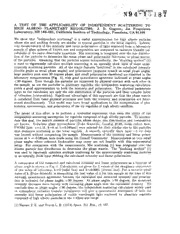
NASA Technical Reports Server (NTRS) 19940011714: A test of the applicability of independent scattering to high albedo planetary regoliths PDF
Preview NASA Technical Reports Server (NTRS) 19940011714: A test of the applicability of independent scattering to high albedo planetary regoliths
v ' A TEST OF THE APPLICABILITY OF INDEP'ENDENT SCATTERING TO HIGH ALBEDO PLANETARY REGOLITHS; J. D. Goguen, Jet Propulsion Laboratory, MS 183-501, California Institue of Technology, Pasadena, CA 91109 We show that "independent scattering" is a useful approximation for high albedo particles whose size and packing density are similar to typical particles in the lunar regolith. Labora- tory measurements of the intensity and linear polarization of light scattered from a laboratory sample of glass spheres of known size and composition are compared to radiative transfer cal- culations of the same observable quantities. Mie scattering is integrated over the size distribu- tion of the particles to determine the mean phase and polarization functions, or phase matrix, of the particles. Assuming that the particles scatter independently, the "doubling method" (1) is used to rigorously calculate multiple scattering in an optically thick layer of these aniso- tropically scattering particles. All of the major features "predicted" in the calculated intensity (double peaks at small phase angles) and polarization (negative branch at small phase angles, large positive peak near 20 degrees phase, and small polarization elsewhere) are observed in the laboratory measurements (Fig. 1), with good quantitative agreement indicated at phase angles <:90 degrees. Even though the particles are supported by physical contact with each other in the sample, as are the particles in planetary regoliths, the independent scattering calculation yields a good approximation to both the intensity and polarization. The physical parameters input to the calculation are only the size distribution of the particles and their complex index of refraction (composition). Significant advantages of this approach are that the phase matrix is calculated from basic physical principles and both the intensity and polarization are deter- mined simultaneously. This model may have broad applications to the interpretation of pho- tometry, spectroscopy, and polarimetry of the icy regoliths of high albedo satellites. The intent of this effort is to perform a controlled experiment that tests the utility of the independent scattering assumption for regoliths composed of high albedo particles. To aecomo- date this goal, the sample consists of particles whose shape, size distribution and composition are known. Soda-lime glass microspheres (Duke Scientific, Catalog #146; mean radius 4pm, FWHM 2/_m; u----1.51, k--_3 at ),_0.589pm) were selected for their similar size to the particles that dominate scattering in the lunar regolith. A smooth, optically thick layer --_1 cm deep was formed without compacting the sample. Measurements of the intensity and linear polari- zation at _ = 0.589/tm were made using the Cornell Goniometer. Measurements at very small phase angles where coherent backscatter may occur are not feasible with this experimental setup. For comparison with the measurements, Mie scattering (1) was integrated over the known particle size distribution to determine the phase matrix. The "doubling method" (1) was used to rigorously calculate multiple scattering by the anisotropically scattering particles in an optically thick layer Fielding the calculated intensity and linear polarization. A comparison of the measured and calculated intensity and linear polarization as a function of I)hasc angle is shown ill Fig. 1. Calculatioas are given for 2 values of the imaginary component of the index of refraction, k=0 (solid line) and k=0.0001 (dotted line). For a suitable small value of k (Duke Scientific is researching the best value of k for this sample at the time of this writing), quantitative agreement between the calculated and measured intensity and polariza- tion is indicated for phase angles <90 degrees. At phase angles >90 degrees, the measured intensity decreases more rapidly with increasing phase angle that the calculated intensity. We conclude that at phase angles <90 degrees, the independent scattering calculation widely used in atmospheric radiative transfer calculations will give a quantitative description of both the intensity and linear polarization of visible wavelength light scattered by planetary regoliths composed of high albedo p_rticles in the 1-101tm size range. (1) Hansen J. E. and Travis L. D. (1974) Space. Sci. Rev., I6, 527. 542 LPSC XXIV INDEPENDENT SCATTERING IN HIGH ALBEDO REGOLITHS: J. D. Goguen I/1:vsPhaseA le Duke lassbeads#146;e=60;32G/50F 1.0 0.8 0.6 0.4 0.2 0.0 , , , I , , , I , , , i , , , I , , , I , , , I , I 0 20 40 60PhaseAng_(8d0egrees) 100 120 140 _oPoLarizatiovns,PhaseAr_cjl(e.D, ukeg_ss be,ads #146;e--60,:32G/50F! , , : i N O. ,'e .8 -I0 = , I , _ , ! , , I , , I , , , I , , , I , , , I i 0 20 40 60 80 I00 120 140 Figure 1. Comparison of laboratory measurements (dots) and rigorous calculations (lines: solid .k:0, dotted k:0.0001) of the intensity (top) and linear polarization (bottom) of an opti- cally thick sample of the glass microspheres (n:l.51) described in the text. The emission angle is fixed at 60 degrees and the incidence angle varies within the pla, ne defined by the surface normal and emission direction• The wavelength of the measurements and calculations is k-----0.589#m. The doubling calculation uses 32 Gaussian ordinates and 50 Fourier coefficients to rigorously calculate tile intensity and polarization scattered from a layer of normal optical del)th T= 1024.
